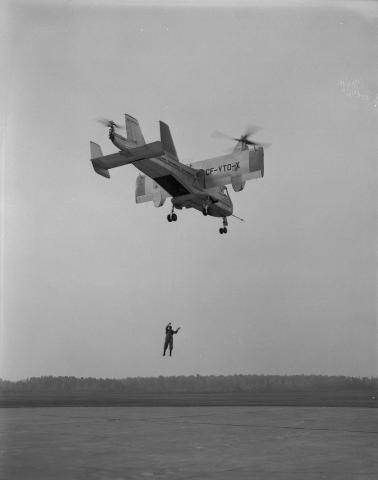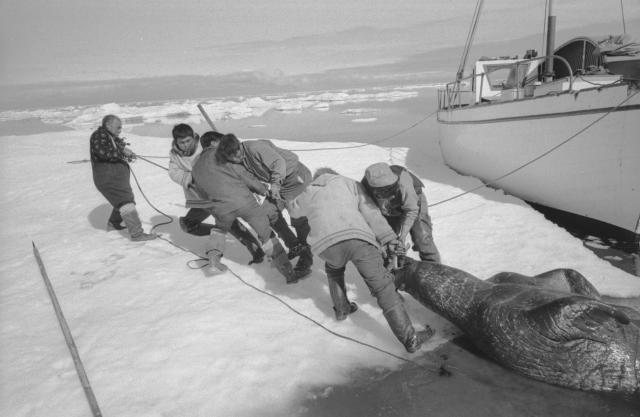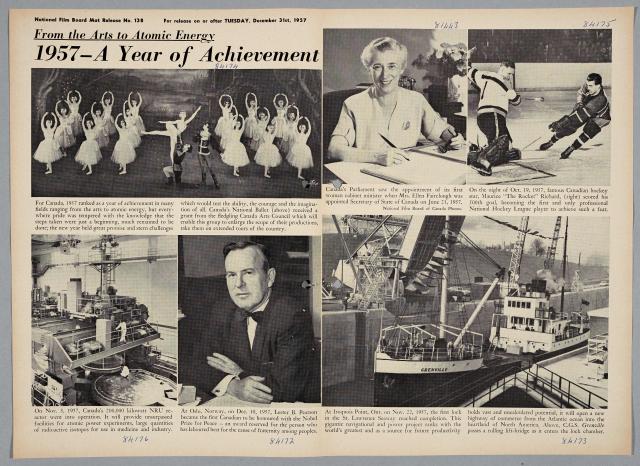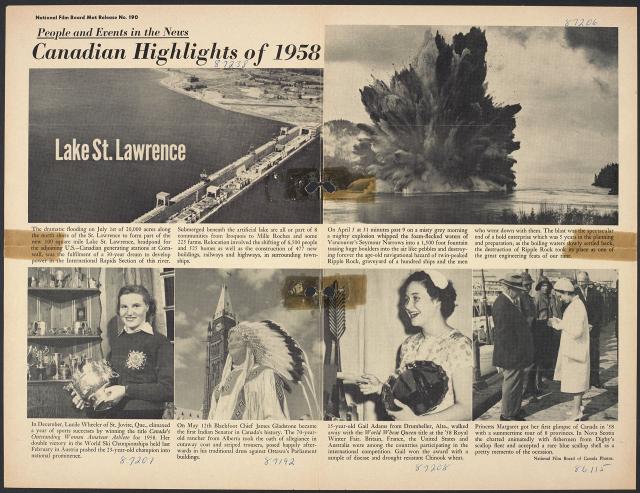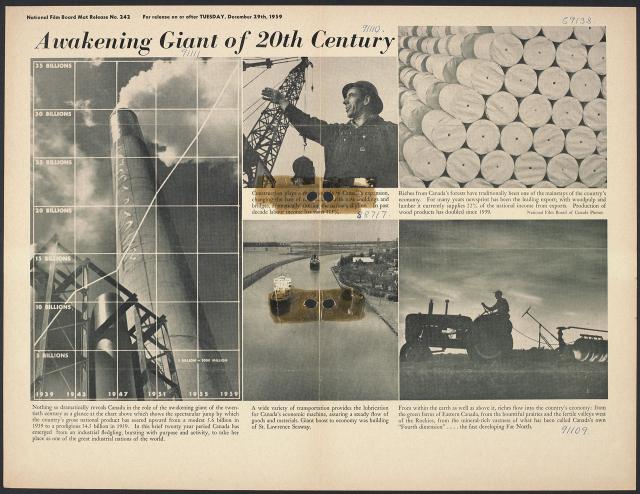
Photostory #502: Canada in the Sixties -- Emergence of an Economic Giant
Photographers
Maker
National Film Board of Canada
Release Date
December 1, 1969
Collection
CMCP fonds
Credit Line
Canadian Museum of Contemporary Photography fonds, National Gallery of Canada Library and Archive
Main Text
In progress Photostory 1/18 : Science, natural resources, engineering projects, secondary industry and people -- these things formed the closely-linked stepping stones by which Canada more than doubled the Gross National Product and advanced across the decade of the sixties to increased stature among the major industrial nations of the worlds._x000B__x000B_SCIENCE_x000B__x000B_In the early part of the decade up went Canada's first radiotelescope near Penticton, British Columbia, a selected geographical location which naturally shielded the big dish from most of the clutter of man-made radio noises. While the federal astrophysicists trained their sensitive antenna on the distant stars other government scientists blazed the trail for the burgeoning Canadian commercial space industry in a fine manner with the lofting up into orbit of Alouette I -- and Canada became the third nation on earth to have a self-made artificial satellite on show._x000B__x000B_And what a fine show it was. Equipped with seemingly tireless solar batteries and ingenious expanding antennas of revolutionary design, Alouette was to chatter on in scientific language for the rest of the decade. And, though joined in later years by two more Canadian scientific satellites of even more complex design, nothing could diminish the prestige of that initial wonderful success._x000B__x000B_Also adding up credits in space were the dependable Black Brant Canadian rockets. Designed to investigate the upper atmosphere and the scientifically-important nearer reaches of space, their solid performances soon led to further development and eventual use by the scientists of several nations. Another space probe known as HARP, began at McGill University in Montreal then took place on a sandy beach in the Barbados, in the West Indies, when a of Canadians adapted a large-calibre naval gun and, in intriguing Jules Verne fashion, fired experimental packages into space at a comparatively very small costs_x000B__x000B_But not all the excitement of technology and its use for investigating the laws of nature was taking place on high. Some Canadians were finding the inner space of the oceans just as compelling and challenging and the building of the Bedford Institute of Oceanography in Nova Scotia together with special research ships to take them from the arctic icefields to the tropics meant Canada was entering into the forefront of this international study. On land other scientists probed down into the upper mantle, gaining valuable knowledge of the earth itself and across the broad rim of the vast Canadian outer arctic a task force known as the Polar Continental Shelf Project was firmly entrenched in an overall study of a hitherto scientifically unknown region._x000B__x000B_During this period, across the land, in government and private industry, research and development was growing apace, a momentum that was to play an important part in making the gross national product soar upwards at a remarkable rate to an estimated 77 billion dollars._x000B__x000B_NATURAL RESOURCES_x000B__x000B_Oil, metals and minerals -- these made the headlines through the sixties. Big gains were made in the forestry and fishery industries, what blossomed brilliantly in mid-decade, but it was these three natural resources that really set the ticker tape a-clacking._x000B__x000B_Oil fever raged across the nation in Alberta, the Northwest Territories, Saskatchewan, British Columbia and Yukon. Its impetus carried it out over the coast lines into the waters of the Pacific, across the Gulf of St. Lawrence and offshore of Nova Scotia and Newfoundland to fabled Sable Island and the Grand Banks. Finally, it carried as fas as the desolate arctic islands, where, as the decade closes, and spurred by nearby success in northern Alaska, it rages unabated._x000B__x000B_Metals entered the sixties with an exotic clinking as the search was on for such space age materials as columbium, cobalt and cesium. Then with the decade not yet at the half-way mark, and with a reverberating clang, Timmins, Ontario, became the focus point of a massive copper-zinc-silver discovery. Other metal developments flourished east and west, a railway was built to Pine Point in the Northwest Territories to carry out the base-metal riches mined there and near Edmonton a new technique meant the production of the first Canadian-made nickel blanks for the mint in Ottawa. Uranium came back to where the money was and new prospecting rushes stirred up the winter snows around Elliot Lake. And, as the money speculators in Europe sent the gold market rocking wildly, owners of uneconomical gold mines in the hinterlands started refiguring their operating costs. But governments held firm and soon gold once more became just a rather valuable yellow metal increasingly useful in industrial processes._x000B__x000B_In Saskatchewan, the big mineral story was the fantastic discovery and extraction of potash. Special railway hopper cars and loading facilities were built to move vast amounts of this prized fertilizer and the flow overseas, via Vancouver, was on. Alberta and British Columbia discovered a ready market for their rich beds of sub-surface soft coal (valuable for making into high-grade metallurgical coke) and preliminary operations commenced for sending large shipments to the Orient. Asbestos became a part of Newfoundland's stirring economy and the advent of color television spurred the search for the "rare earths" needed in their manufacture._x000B__x000B_One mineral in particular -- the most precious of them all -- which Canada has in great abundance became of immediate international importance. Water, clean unspoilt water, so long taken for granted and considered the cheapest commodity on the face of the earth, suddenly, so it seemed, became one of the gravest problems on the North American continent. Towards the end of the decade, with the matter a recurring topic of discussion and concern at all levels of society the first laborious efforts aimed at stemming the life-destroying tide of water pollution hopefully became reality._x000B__x000B_ENGINEERING PROJECTS_x000B__x000B_The decade past will no doubt be remembered as the year of the great Canadian dams. Peace River, Manicouagan, South Saskatchewan, Mactaquac, Churchill Falls and other hydroelectric projects rose up in awesome man-made ponderous majesty. They blocked the paths of mighty rivers, created vast lakes rivalling those of nature and changed whole landscapes. They added million upon million of kilowatts to the nation's power reserves and pushed the wilderness frontier still further back._x000B__x000B_In transportation the early part of the decade saw the opening of the trans-Canada highway, many new modern airports, some with international stature, and broad new expressways linking heavy centers of population. The big cities rose ever higher, Montreal built its modern metro -- everywhere construction materials in general were being used in quantities as never before._x000B__x000B_During the sixties Canada went from being not only a storehouse of raw materials but a supplier of finished and manufactured items of all descriptions. The steel and specialty steel industry boomed, reaching peak capacity with orders from around the world. In the aerospace industry, which underwent amazingly sophisticated expansion, products ranged from a tilt-wing cargo aircraft to a water-bomber aircraft, to spacecraft parts (the first men on the moon, Armstrong and Aldrin, had Canadian-made legs on their Lunar Excursion Module), small hovercraft, Concorde simulators and complex navigational systems. Also in electronics, Canadian companies designed and made electronic switching for telephones, computers and microsystems which have led their fields. The Canadian automobile industry made production export history. The first aluminum houses rolled off the production lines. Heavy engineering items and machinery were sold in scores of countries. During these years also, significant strides in the establishment of increased secondary industries were made across the prairies and in the maritimes._x000B__x000B_PEOPLE_x000B__x000B_In the sixties Canadians broke through the 20-million-population mark and celebrated the nation's Centennial with a gusto that surprised everyone -- especially themselves. A steady influx of new citizens from many countries added to the already cosmopolitan character of the country. Longer-established Canadians, in tune with the quickening tempo of growth and change, moved from city to city and province to province in large numbers, reshuffling the widely-spread population into a new knowledge of its individual parts. Other Canadians who got itchy feet in the 1960's joined the forefront of the jet set and became well known as globetrotters in the capitals of the world._x000B__x000B_Meanwhile, back in Canada, social services were on the increase and living standards --which during this decade were compared favourably with those of any other country -- were being given practical thought. Upon the resulting framework of the Canada Pension Plan and Medicare programs the future of Canadian society promises well. The decade to come should indeed see the continuing vigor and excitement of life in a rich, developing nation where people are free to pursue their own fortunes according to their inclinations.
Subjects:
Year End Review, Science, Commercial activity, Natural resources, Engineering, Research, Polar Continental Shelf Project, Transportation, Highways, Trans-Canada Highway, Environment and ecology, Commercial activity, Natural resources, Oil, Sports, recreation and hobbies, Commercial activity, Shipping, Commercial activity, Trade and export, Transportation, Public transit, Special events, Expo 67, Aboriginal Peoples, Inuit
Locations:


